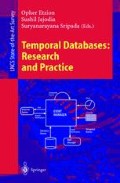Abstract
A significant property of temporal data is their richness of semantics. Although several temporal data models and query languages have been designed specifically to handle the temporal data, users must still deal with much of the implicit temporal information, which can be automatically derived from the stored data in certain situations. We propose a multidatabase architecture where an appropriate formalization of the intended semantics is associated with each temporal relation and temporal database. This allows a temporal mediator to access the databases to retrieve implicit information in terms of time granularities different from those used to store data. We also describe how the temporal mediator can provide a user interface to the multidatabase system allowing temporal queries in terms of arbitrary granularities and involving relations in different TDBMS.
The work was partially supported by the National Science Foundation (NSF) under the grant IRI-9633541. The work of Wang was also partially supported by the NSF grant IRI-9409769.
Preview
Unable to display preview. Download preview PDF.
References
C. Bettini, X. Wang, and S. Jajodia. Temporal Semantic Assumptions and Their Use in Databases. IEEE Transactions on Knowledge and Data Engineering. To appear.
C. Bettini, X. Wang, and S. Jajodia. A General Framework for Time Granularity and its Application to Temporal Reasoning. Annals of Mathematics and Artificial Intelligence, to appear. A preliminary version of this paper appeared in Proc. of TIME-96, IEEE Computer Society Press.
M. H. Bohlen. Temporal Database System Implementations. SIGMOD Record, 24(4), ACM, December 1995.
J. Clifford and D.S. Warren. Formal semantics for time in databases. ACM Transactions on Database Systems, 8(2):214–254, June 1983.
J. Clifford and T. Isakowitz. On the semantics of (bi)temporal variable databases. In M. Jarke, J. Bubenko, and K. Jeffery, editors, Proceedings of 4th International Conference on Extending Database Technology, pages 215–230, March 1994.
J. Clifford, C.E. Dyreson, T. Isakowitz, C.S. Jensen and R. Snodgrass. On the Semantics of “Now” in Databases. ACM Transactions on Database Systems, 1997. To appear.
R. Chandra, A. Segev, and M. Stonebraker, Implementing calendars and temporal rules in next generation databases, in Proc. of ICDE, 1994, pp. 264–273.
W. Du and M. Shan. Query Processing in Pegasus. In Object-oriented multidatabase systems, O.A. Bukhres and A.K. Elmagarmid Eds., Prentice Hall, 1996.
M. Niezette and J. Stevenne. An efficient symbolic representation of periodic time. In First International Conference on Information and Knowledge Management, Baltimore, MD, November 1992.
N. Piccioni. Using semantic assumptions to answer temporal queries. Master Thesis. DSI—University of Milan, 1997. (In Italian)
E. Sciore, M. Siegel, and A.S. Rosenthal. Using semantic values to facilitate interoperability among heterogeneous information systems. ACM Transactions on Database Systems, 19(2):254–290, June 1994.
A. Segev and A. Shoshani. Logical modeling of temporal data. In U. Dayal and I. Traiger, editors, Proceedings of the ACM SIGMOD Annual Conference on Management of Data, pages 454–466, San Francisco, CA, May 1987.
R. T. Snodgrass, editor. The TSQL2 Temporal Query Language. Kluwer Academic Publishers, 1995.
A.U. Tansel, J. Clifford, S. Gadia, S. Jajodia, A. Segev, and R. Snodgrass. Temporal Databases: Theory, Design, and Implementation. Benjamin/Cummings, 1993.
G. Wiederhold. Mediators in the architecture of future information systems. IEEE Computer, March, 1992, pages 38–49.
G. Wiederhold, S. Jajodia, and W. Litwin. Dealing with granularity of time in temporal databases. In Proc. 3rd Nordic Conf. on Advanced Information Systems Engineering, Trondheim, Norway, May 1991.
X. Wang, S. Jajodia, and V.S. Subrahmanian. Temporal modules: An approach toward federated temporal data bases. In Proc. of ACM SIGMOD International Conference on the Management of Data, Washington, D.C., 1993.
Author information
Authors and Affiliations
Editor information
Rights and permissions
Copyright information
© 1998 Springer-Verlag Berlin Heidelberg
About this chapter
Cite this chapter
Bettini, C., Wang, X.S., Jajodia, S. (1998). An architecture for supporting interoperability among temporal databases. In: Etzion, O., Jajodia, S., Sripada, S. (eds) Temporal Databases: Research and Practice. Lecture Notes in Computer Science, vol 1399. Springer, Berlin, Heidelberg. https://doi.org/10.1007/BFb0053697
Download citation
DOI: https://doi.org/10.1007/BFb0053697
Published:
Publisher Name: Springer, Berlin, Heidelberg
Print ISBN: 978-3-540-64519-1
Online ISBN: 978-3-540-69799-2
eBook Packages: Springer Book Archive

